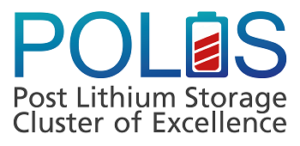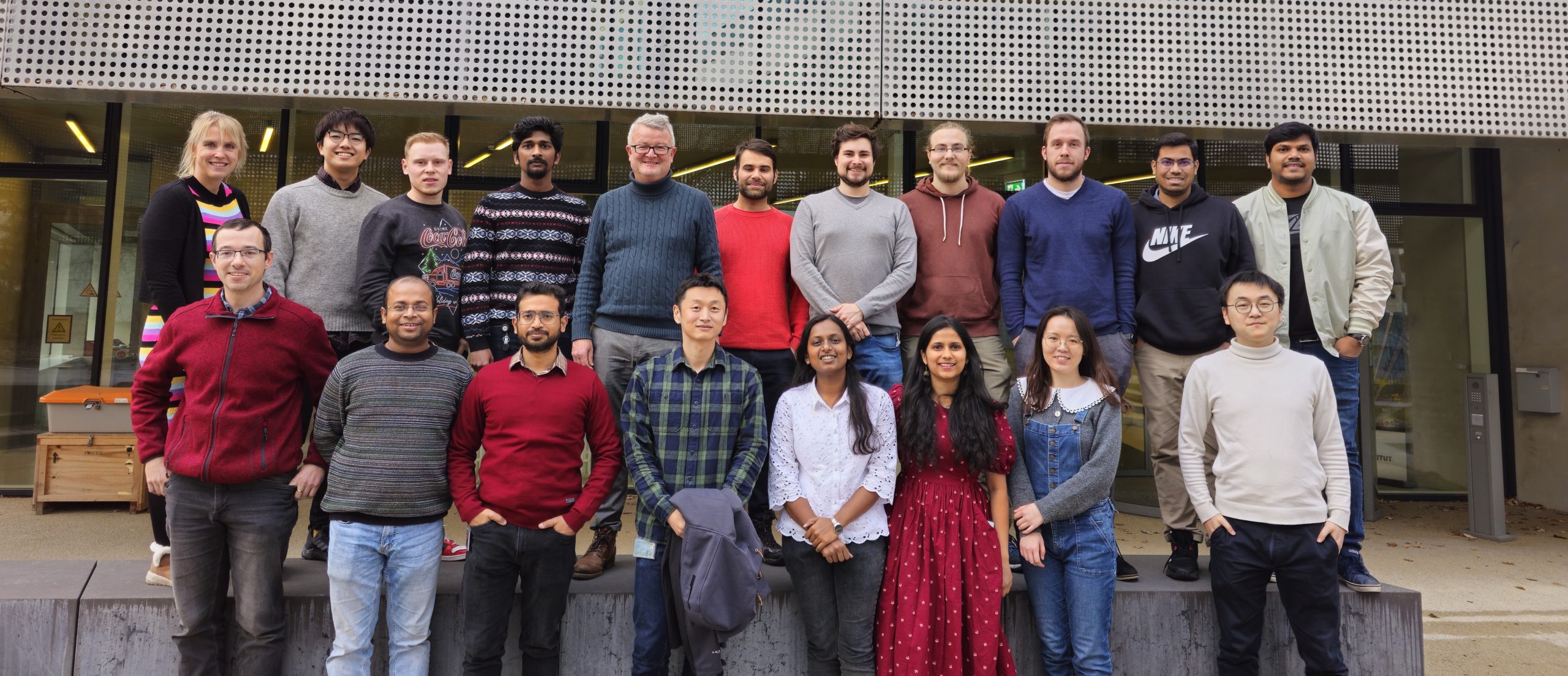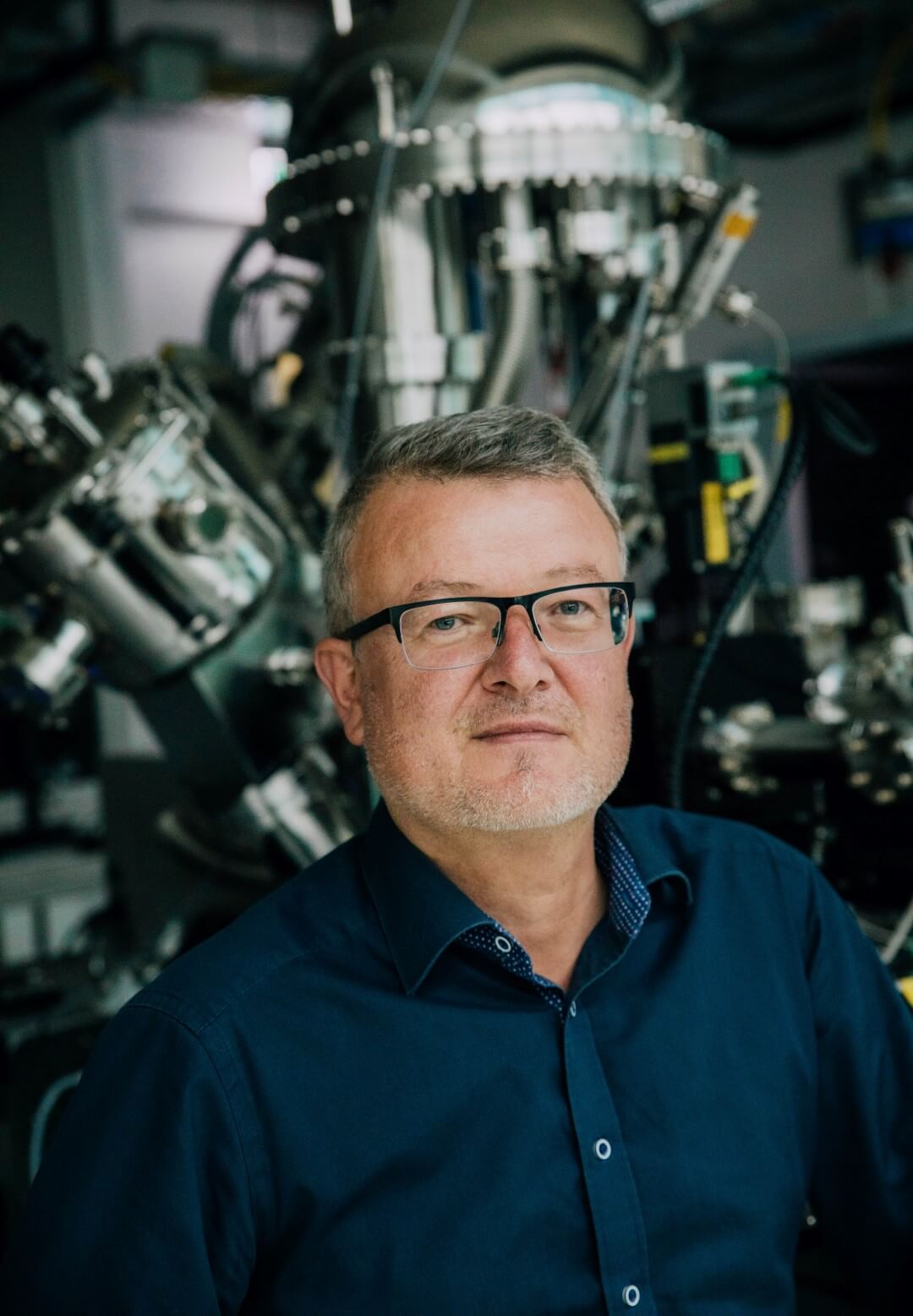HIU-Newsletter
You a scientist yourself? A journalist, a political decision-maker or business representative? In our newsletters we compile the latest battery research news for you. Specially tailored to your personal area of interest.
Die Forschungsgruppe "Solid State Chemistry" am HIU ist eine interdisziplinäre Forschungsgruppe, in welcher Chemiker, Physiker und Ingenieure tätig sind. Ihr Fokus liegt auf der Untersuchung sogenannter "Batteries beyond Lithium"-Batterien jenseits der Lithium-Ionen-Batteriesysteme. Parallel werden neue, alternative Lösungsansätze für die Lithium-freie-Batterien entwickelt.
Lithium-Ionen-Batterien sind zwar weit verbreitet, jedoch ist ihre Speicherkapazität begrenzt. In Zukunft werden vor allem für die Elektromobilität Batteriesysteme mit höherer Energiedichte gefragt sein, die bei geringerem Gewicht mehr elektrische Energie speichern können. Gefragt sind zukünftig auch lithiumfreie Batterien, die eine deutlich höhere Speicherkapazität und verbesserte Sicherheitseigenschaften aufweisen.
Mit diesen Arbeiten soll der Grundstein für neuartige, leistungsfähigere Batterien gelegt werden. Untersucht wird unter anderem das Potenzial unterschiedlicher Batteriematerialien, um die Energiedichte heutiger Batterie-Systeme zu erhöhen. Beispiele hierfür sind aktuell die Fluorid- und Chlorid-Ionen-Batterie, welche beide das Potential haben, die Speicherkapazität der Lithium-Ionen-Batterie signifikant zu überschreiten.
Darüber hinaus wird derzeit an Magnesium-Batterien geforscht, welche ebenfalls vergleichsweise hohe Energiedichten aufweisen. Des Weiteren beschäftigt sich die Forschungsgruppe mit der Entwicklung sogenannter Aktivmaterialien (u.a. Elektrodenmaterialien). Hier stehen u.a. Sicherheitsaspekte im Vordergrund.
Um elektrochemische Energiespeicher effizienter zu gestalten, werden auch neue Anoden- und Kathodenmaterialien aus Nanokompositen entwickelt und getestet.
Die Gruppe „Festkörperchemie“ am HIU leistet in POLiS zu verschiedenen Forschungsfeldern Beiträge: bei Na-Ionenbatterien entwickeln wir zyklenfeste Kathodenmaterialien auf der Basis von Schichtoxiden sowie neuartige, ionenleitende und wasserlösliche anorganische Bindermaterialien. Im Bereich multivalente Systeme wie Mg- und Ca-Batterien entwickeln wir neue Elektrolyte mit hoher ionischer Leitfähigkeit und Stabilität sowie Kathoden auf der Basis organischer Materialien und Schwefelkathoden. Weiteres Forschungsfeld sind neue hochleistungsfähige Anoden, insbesondere bei Ca-Batterien sowie Schutzschichten und Gel-Polymerelektrolyte. Im Forschungsfeld Anionische Systeme erweitern wir den Werkzeugkasten durch die Entwicklung neuer Kathoden- und Anodenmaterialien sowie von Festkörperelektrolyten.

Diese Forschungsgruppe wird teilweise von der Deutschen Forschungsgesellschaft (DFG) durch den Exzellenzcluster POLiS gefördert.

In search of new concepts to build batteries with high energy densities, electrochemical cells based on metal fluorides may be promising.
We have demonstrated the first reversibly working battery cells based on fluoride shuttle. In secondary fluoride batteries, fluoride anion acts as charge transfer ion between a metal/ metal fluoride pair where it will react with metal or evolve from metal fluoride depending on the flow of current. The theoretical capacity can be several times higher than that of conventional Lithium Ion Batteries, depending on the combination of metal and metal Fluoride.
The Chloride Ion Battery (CIB) is a logical consequence of the development of the Fluoride Ion Battery. Also here, singly charged negative ions shuttle between cathode and anode where metal chlorides are either formed or reduced to the metal depending on whether the battery is charged or discharged.The group has demonstrated the proof-of-principle and built first cells of this kind. Ionic liquids have been used as elecrolytes at room temperature.
Magnesium as anode material has the potential advantage of a high theoretical volumetric capacity of 3832 mAh/cm3 (Lithium: 2062 mAh/cm3), its electrochemical potential is -2.37 V vs. NHE. Interestingly, Magnesium does not form dendrites when electrodeposited and can therefore be used in metallic form, thus avoiding inert host materials like in the Lithium/Graphite system. Magnesium is environmentally benign, safe to handle and of low cost compared to lithium. A particular challenge is the development of an electrolyte for reversible Magnesium shuttle. We have developed a non-nucleophilic electrolyte which is synthesized from standard chemicals, shows a high stripping/plating efficiency and has an unprecedented electrochemical stability window of 3.9 V and Coulombic efficiency of >99%. The electrolyte is compatible with a sulfur cathode and it opens the door to the development and application of new high voltage cathodes for Magnesium Batteries.
Using a sulfur/CMK-3 composite as cathode, Mg metal as anode and the designed electrolyte in tetraglyme or a binary solvent of glyme and PP14TFSI, the discharge performance and the cyclability of the batteries was considerably improved compared to the first report on Mg/S battery where an HMDS based electrolyte was used in THF solution. The electrochemical conversion of magnesium and sulfur via the formation of a series of intermediate polysulfide MgSx (2<x<8) has been verified by means of various analytical and electrochemical techniques.
Interestingly, the discharge occurs close to the theoretical voltage of 1.7 V with the new electrolyte.
(Zh. Zhao-Karger, X. Zhao, D. Wang, Th. Diemant, R.J. Behm, and M. Fichtner: Performance Improvement of Magnesium Sulfur Batteries with Modified Non-Nucleophilic Electrolytes. Advanced Energy Materials. Article first published online: 6 OCT 2014. DOI: 10.1002/aenm.201401155)
A major issue in Metal-Sulfur Batteries is the formation of polysulfide intermediates during the transition from neutral S8 to Li2S and Li2S2 during discharge. The longer polysulfides are soluble in the electrolyte, which leads to gradual dissolution of the cathode, to self-discharge and a multistep voltage profile, due to different subsequent reactions.
By extensive XPS studies of the subsurface region we have shown now that a simple, coconut based active carbon with ultramicropores (ca. 0.6 nm diameter) does not allow infiltration of the large S8 rings, nor does it allow formation of soluble polysulfides. Rather, one direct transition from smaller sulfur species to Li sulfide and -disulfide is observed. No polysulfides have been found in the electrolyte and there is only one voltage plateau (M. Helen, M. Anji Reddy, T. Diemant, U. Golla-Schindler, R. J. Behm, and M. Fichtner (2015) submitted)
Tip Enhanced Raman Spectroscopy is an analytical tool which gives chemical and topographic information in the same time. It is a possibility to analyse surfaces with a resolution on nanometer scale. In battery research it is often not well-‐known, what is going on at surfaces and interfaces like the Solid Electrolyte Interface. The aim of this project is a better understanding of processes in these layers.
(images will be uploaded shortly)
Der Exzellenzcluster POLiS erforscht neue Batteriematerialien und Technologiekonzepte für eine leistungsfähige und nachhaltige Speicherung elektrischer Energie. Ziel des Clusters ist es, Elektrodenmaterialien und Elektrolyte zu entwickeln, die nachhaltige Systeme auf der Basis von Natrium-, Magnesium-, Aluminium-, Kalzium- und Chlor-Ionen ermöglichen. Größere Hürden für Entwicklung und Einsatz von Post-Lithium-Systemen und damit die Legitimation für unsere Forschung sind: (1) Niedrige Mobilität von Ionen in Festkörpern und Flüssigkeiten, (2) Fehlen maßgeschneiderter Materialgrenzflächen mit geeigneten Ladungstransfer-Eigenschaften, (3) schnelle Alterung von Aktivmaterialien und Elektrolyt, (4) unzureichende Reversibilität bei Be- und Entladeprozessen.
https://www.postlithiumstorage.org/de/
CELEST bündelt das Know-how von 31 Instituten seiner Partnerinstitutionen: Karlsruher Institut für Technologie (KIT), Universität Ulm und Zentrum für Sonnenenergie- und Wasserstoff-Forschung Baden-Württemberg (ZSW). CELEST zielt darauf ab, die Kommunikation und Zusammenarbeit zwischen den beteiligten Wissenschaftlern zu verbessern und den Weg für neue, interdisziplinäre Kooperationen zu ebnen. CELEST koordiniert gemeinsame Aktivitäten mit anderen Universitäten und Forschungseinrichtungen sowie mit der Industrie im In- und Ausland.
Forscher aus fünf europäischen Forschungsinstituten (das HIU, die französische Alternative Energie- und Atomenergiekommission CEA, die Technische Universität Dänemark DTU, die schwedische Universität Uppsala und das slowenische Kemijski Institut NKI arbeiten gemeinsam im EU-finanzierten Projekt „LiRichFCC“ Li-Ionen-Batterien zusammen. Auf der Grundlage eines neuen Konzeptes von Li-reichen Salzgesteinsstrukturen lassen sich Energiespeicherdichten über die bisher bekannten System hinaus erhöhen.
Das Projekt ist eine Kooperation zwischen dem HIU, dem DLR Stuttgart, der FhG-ISIT, CustomCells GmbH, der El-Cell GmbH und der Schaeffler AG mit dem Ziel, die Magnesium-Sulfur-Technologie auf Demonstrationsebene zu betreiben. Das technische Ziel ist die Herstellung und Prüfung von 20 Ah Mg-S Zellen.
Titel: „Novel in situ and in operando techniques for characterization of interfaces in electrochemical storage systems“. 8 Partner aus DK, UK, F, D mit assoziierten Partnern aus Korea and USA. Gemeinsam arbeiten die Projektpartner an internen und externen Grenzflächen von Batteriematerialien.
ProEco ist eine gemeinschafliches Projekt für Nanomaterialien für Anwendungen im Bereich der Energiespeicherung. Partner sind: DTU Energy Conversion, Aarhus University inano, Danish Technological Institute, Haldar Topsoe AS, Topsoe Fuel Cells, MPI für Kolloid und Grenzflächenforschung und KIT.
Das Projekt beschäftigt sich mit neuen Batteriematerialien basierend auf Magnesium-Nanomaterialien für angewandte, wieder aufladbare Batterien. Partner des Projekts sind: CNRS-ICMP France, KIT Germany, IFE Norway, RAS IPCP Russia, MSU Russia, St. Peterburg Univ. Russia, ISSP Russia
Das Projekthaus e-drive ist eine strategische Allianz mit Daimler zum Thema Elektromobilität bzw. Elektroantriebe.
Die Allianz Projekthaus e-drive
CUSTOMCELLS® is one of the world’s leading companies in the development of special lithium-ion battery cells. CUSTOMCELLS® – Made in Germany – develops and produces application-specific battery cells from prototypes to small and medium series. On the basis of flexible manufacturing concepts and state-of-the-art research and production facilities, CUSTOMCELLS® guarantees high-tech solutions for special applications and – depending on the customer requirement profile – tailor-made development and production of electrodes, electrolytes, battery cells and battery modules. With access to 14 industrialized electrode technologies, over 250 raw materials in stock and a production facility equipped with state-of-the-art electrode and cell manufacturing machines, CUSTOMCELLS® is one of the leading manufacturers of customized battery cells.
In search of new concepts to build batteries with high energy densities, electrochemical cells based on metal fluorides may be promising.
We have demonstrated the first reversibly working battery cells based on fluoride shuttle. In secondary fluoride batteries, fluoride anion acts as charge transfer ion between a metal/ metal fluoride pair where it will react with metal or evolve from metal fluoride depending on the flow of current. The theoretical capacity can be several times higher than that of conventional Lithium Ion Batteries, depending on the combination of metal and metal Fluoride.
The Chloride Ion Battery (CIB) is a logical consequence of the development of the Fluoride Ion Battery. Also here, singly charged negative ions shuttle between cathode and anode where metal chlorides are either formed or reduced to the metal depending on whether the battery is charged or discharged.The group has demonstrated the proof-of-principle and built first cells of this kind. Ionic liquids have been used as elecrolytes at room temperature.
Magnesium as anode material has the potential advantage of a high theoretical volumetric capacity of 3832 mAh/cm3 (Lithium: 2062 mAh/cm3), its electrochemical potential is -2.37 V vs. NHE. Interestingly, Magnesium does not form dendrites when electrodeposited and can therefore be used in metallic form, thus avoiding inert host materials like in the Lithium/Graphite system. Magnesium is environmentally benign, safe to handle and of low cost compared to lithium. A particular challenge is the development of an electrolyte for reversible Magnesium shuttle. We have developed a non-nucleophilic electrolyte which is synthesized from standard chemicals, shows a high stripping/plating efficiency and has an unprecedented electrochemical stability window of 3.9 V and Coulombic efficiency of >99%. The electrolyte is compatible with a sulfur cathode and it opens the door to the development and application of new high voltage cathodes for Magnesium Batteries.
Using a sulfur/CMK-3 composite as cathode, Mg metal as anode and the designed electrolyte in tetraglyme or a binary solvent of glyme and PP14TFSI, the discharge performance and the cyclability of the batteries was considerably improved compared to the first report on Mg/S battery where an HMDS based electrolyte was used in THF solution. The electrochemical conversion of magnesium and sulfur via the formation of a series of intermediate polysulfide MgSx (2<x<8) has been verified by means of various analytical and electrochemical techniques.
Interestingly, the discharge occurs close to the theoretical voltage of 1.7 V with the new electrolyte.
(Zh. Zhao-Karger, X. Zhao, D. Wang, Th. Diemant, R.J. Behm, and M. Fichtner: Performance Improvement of Magnesium Sulfur Batteries with Modified Non-Nucleophilic Electrolytes. Advanced Energy Materials. Article first published online: 6 OCT 2014. DOI: 10.1002/aenm.201401155)
A major issue in Metal-Sulfur Batteries is the formation of polysulfide intermediates during the transition from neutral S8 to Li2S and Li2S2 during discharge. The longer polysulfides are soluble in the electrolyte, which leads to gradual dissolution of the cathode, to self-discharge and a multistep voltage profile, due to different subsequent reactions.
By extensive XPS studies of the subsurface region we have shown now that a simple, coconut based active carbon with ultramicropores (ca. 0.6 nm diameter) does not allow infiltration of the large S8 rings, nor does it allow formation of soluble polysulfides. Rather, one direct transition from smaller sulfur species to Li sulfide and -disulfide is observed. No polysulfides have been found in the electrolyte and there is only one voltage plateau (M. Helen, M. Anji Reddy, T. Diemant, U. Golla-Schindler, R. J. Behm, and M. Fichtner (2015) submitted)
Tip Enhanced Raman Spectroscopy is an analytical tool which gives chemical and topographic information in the same time. It is a possibility to analyse surfaces with a resolution on nanometer scale. In battery research it is often not well-‐known, what is going on at surfaces and interfaces like the Solid Electrolyte Interface. The aim of this project is a better understanding of processes in these layers.
(images will be uploaded shortly)
Der Exzellenzcluster POLiS erforscht neue Batteriematerialien und Technologiekonzepte für eine leistungsfähige und nachhaltige Speicherung elektrischer Energie. Ziel des Clusters ist es, Elektrodenmaterialien und Elektrolyte zu entwickeln, die nachhaltige Systeme auf der Basis von Natrium-, Magnesium-, Aluminium-, Kalzium- und Chlor-Ionen ermöglichen. Größere Hürden für Entwicklung und Einsatz von Post-Lithium-Systemen und damit die Legitimation für unsere Forschung sind: (1) Niedrige Mobilität von Ionen in Festkörpern und Flüssigkeiten, (2) Fehlen maßgeschneiderter Materialgrenzflächen mit geeigneten Ladungstransfer-Eigenschaften, (3) schnelle Alterung von Aktivmaterialien und Elektrolyt, (4) unzureichende Reversibilität bei Be- und Entladeprozessen.
https://www.postlithiumstorage.org/de/
CELEST bündelt das Know-how von 31 Instituten seiner Partnerinstitutionen: Karlsruher Institut für Technologie (KIT), Universität Ulm und Zentrum für Sonnenenergie- und Wasserstoff-Forschung Baden-Württemberg (ZSW). CELEST zielt darauf ab, die Kommunikation und Zusammenarbeit zwischen den beteiligten Wissenschaftlern zu verbessern und den Weg für neue, interdisziplinäre Kooperationen zu ebnen. CELEST koordiniert gemeinsame Aktivitäten mit anderen Universitäten und Forschungseinrichtungen sowie mit der Industrie im In- und Ausland.
Forscher aus fünf europäischen Forschungsinstituten (das HIU, die französische Alternative Energie- und Atomenergiekommission CEA, die Technische Universität Dänemark DTU, die schwedische Universität Uppsala und das slowenische Kemijski Institut NKI arbeiten gemeinsam im EU-finanzierten Projekt „LiRichFCC“ Li-Ionen-Batterien zusammen. Auf der Grundlage eines neuen Konzeptes von Li-reichen Salzgesteinsstrukturen lassen sich Energiespeicherdichten über die bisher bekannten System hinaus erhöhen.
Das Projekt ist eine Kooperation zwischen dem HIU, dem DLR Stuttgart, der FhG-ISIT, CustomCells GmbH, der El-Cell GmbH und der Schaeffler AG mit dem Ziel, die Magnesium-Sulfur-Technologie auf Demonstrationsebene zu betreiben. Das technische Ziel ist die Herstellung und Prüfung von 20 Ah Mg-S Zellen.
Titel: „Novel in situ and in operando techniques for characterization of interfaces in electrochemical storage systems“. 8 Partner aus DK, UK, F, D mit assoziierten Partnern aus Korea and USA. Gemeinsam arbeiten die Projektpartner an internen und externen Grenzflächen von Batteriematerialien.
ProEco ist eine gemeinschafliches Projekt für Nanomaterialien für Anwendungen im Bereich der Energiespeicherung. Partner sind: DTU Energy Conversion, Aarhus University inano, Danish Technological Institute, Haldar Topsoe AS, Topsoe Fuel Cells, MPI für Kolloid und Grenzflächenforschung und KIT.
Das Projekt beschäftigt sich mit neuen Batteriematerialien basierend auf Magnesium-Nanomaterialien für angewandte, wieder aufladbare Batterien. Partner des Projekts sind: CNRS-ICMP France, KIT Germany, IFE Norway, RAS IPCP Russia, MSU Russia, St. Peterburg Univ. Russia, ISSP Russia
Das Projekthaus e-drive ist eine strategische Allianz mit Daimler zum Thema Elektromobilität bzw. Elektroantriebe.
Die Allianz Projekthaus e-drive
CUSTOMCELLS® is one of the world’s leading companies in the development of special lithium-ion battery cells. CUSTOMCELLS® – Made in Germany – develops and produces application-specific battery cells from prototypes to small and medium series. On the basis of flexible manufacturing concepts and state-of-the-art research and production facilities, CUSTOMCELLS® guarantees high-tech solutions for special applications and – depending on the customer requirement profile – tailor-made development and production of electrodes, electrolytes, battery cells and battery modules. With access to 14 industrialized electrode technologies, over 250 raw materials in stock and a production facility equipped with state-of-the-art electrode and cell manufacturing machines, CUSTOMCELLS® is one of the leading manufacturers of customized battery cells.
 Prof. Dr. Maximilian Fichtner Solid-State Chemistry
Prof. Dr. Maximilian Fichtner Solid-State ChemistryORCID: 0000-0002-7127-1823
SciProfiles: 2385097
ResearcherID: A-4731-2013
Scopus Author ID: 6701819223
Katja Vetter
Office Prof. Dr Maximilian Fichtner
Tel: +49 (0731) 50 34020
Mail: katja.vetter@kit.edu
You a scientist yourself? A journalist, a political decision-maker or business representative? In our newsletters we compile the latest battery research news for you. Specially tailored to your personal area of interest.